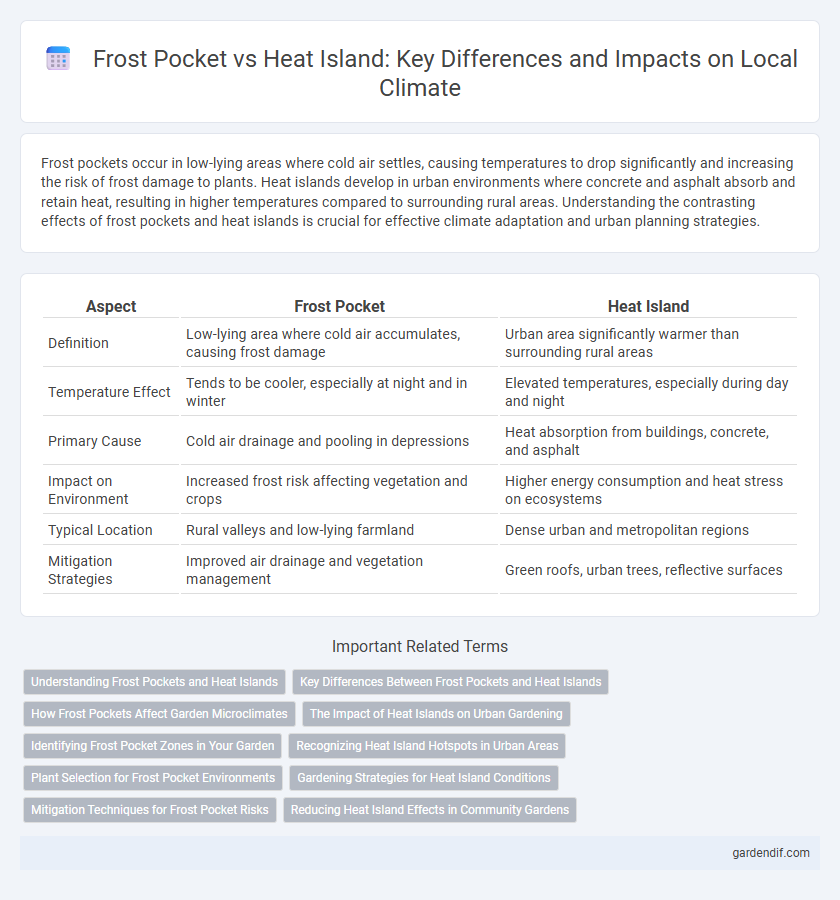
Frost pocket vs Heat island Illustration
Frost pockets occur in low-lying areas where cold air settles, causing temperatures to drop significantly and increasing the risk of frost damage to plants. Heat islands develop in urban environments where concrete and asphalt absorb and retain heat, resulting in higher temperatures compared to surrounding rural areas. Understanding the contrasting effects of frost pockets and heat islands is crucial for effective climate adaptation and urban planning strategies.
Table of Comparison
| Aspect | Frost Pocket | Heat Island |
|---|---|---|
| Definition | Low-lying area where cold air accumulates, causing frost damage | Urban area significantly warmer than surrounding rural areas |
| Temperature Effect | Tends to be cooler, especially at night and in winter | Elevated temperatures, especially during day and night |
| Primary Cause | Cold air drainage and pooling in depressions | Heat absorption from buildings, concrete, and asphalt |
| Impact on Environment | Increased frost risk affecting vegetation and crops | Higher energy consumption and heat stress on ecosystems |
| Typical Location | Rural valleys and low-lying farmland | Dense urban and metropolitan regions |
| Mitigation Strategies | Improved air drainage and vegetation management | Green roofs, urban trees, reflective surfaces |
Understanding Frost Pockets and Heat Islands
Frost pockets occur in low-lying areas where cold air collects, leading to lower temperatures and increased frost risk, while heat islands develop in urban zones due to heat-absorbing surfaces like concrete and asphalt, causing elevated local temperatures. Understanding these phenomena is crucial for microclimate management, as frost pockets can damage crops and vegetation, whereas heat islands exacerbate energy consumption and heat-related health issues. Effective urban planning and vegetation strategies help mitigate the adverse effects of both frost pockets and heat islands on the environment and human well-being.
Key Differences Between Frost Pockets and Heat Islands
Frost pockets are low-lying areas where cold air settles, causing temperatures to drop significantly and resulting in localized frost formation, especially during clear, calm nights. Heat islands occur in urban environments where human activities, dense buildings, and asphalt surfaces absorb and retain heat, leading to higher temperatures than surrounding rural areas. Key differences include their temperature behavior--frost pockets experience cooler microclimates due to cold air drainage, while heat islands exhibit intensified warmth, influencing vegetation, energy usage, and local weather patterns differently.
How Frost Pockets Affect Garden Microclimates
Frost pockets form in low-lying areas where cold air settles, increasing the risk of frost damage to sensitive plants by creating localized microclimates with lower temperatures than surrounding regions. These cold pockets can delay plant growth and reduce crop yields by exposing plants to freezing conditions more frequently than elevated or well-drained sites. Understanding the presence of frost pockets helps gardeners select frost-resistant species and implement protective measures such as mulching or frost cloths to optimize garden microclimates.
The Impact of Heat Islands on Urban Gardening
Heat islands significantly raise temperatures in urban areas, causing increased evaporation and soil moisture loss that stress plants in urban gardens. This intensified heat can shorten growing seasons and reduce yields by accelerating plant respiration and water demand. Unlike frost pockets, which affect plants through cold air drainage and localized frost risk, heat islands create persistent thermal stress that challenges urban gardeners to manage irrigation and crop selection carefully.
Identifying Frost Pocket Zones in Your Garden
Frost pocket zones in a garden are low-lying areas where cold air accumulates, often resulting in significantly lower temperatures compared to surrounding regions. Identifying these zones involves observing plant damage patterns following cold nights and using temperature sensors at ground level to detect colder microclimates. Mitigation strategies include enhancing air drainage by adjusting landscape contours and selecting frost-resistant plants for vulnerable spots.
Recognizing Heat Island Hotspots in Urban Areas
Heat island hotspots in urban areas emerge where dense infrastructure traps heat, causing temperatures to soar significantly above surrounding rural zones. Identifying these zones involves mapping impervious surfaces, vegetation scarcity, and localized temperature spikes using satellite thermal imagery and ground sensors. Understanding heat island distribution aids urban planners in implementing green infrastructure and cooling strategies to mitigate extreme temperature impacts.
Plant Selection for Frost Pocket Environments
Plants selected for frost pocket environments must exhibit high frost tolerance and the ability to thrive in colder microclimates created by cold air drainage and pooling. Species such as cold-hardy evergreens, deciduous shrubs, and perennials with delayed blooming periods reduce frost damage risks. Proper plant selection in frost pockets enhances survival rates and maintains ecosystem stability compared to heat island environments that favor heat-tolerant and drought-resistant species.
Gardening Strategies for Heat Island Conditions
In urban gardening, heat islands create microclimates where temperatures remain elevated compared to surrounding rural areas, intensifying heat stress on plants and soil moisture depletion. Frost pockets, conversely, are low-lying areas where cold air settles, increasing frost risk and damage to sensitive vegetation. To optimize gardening in heat island conditions, utilize heat-tolerant plant species, implement mulching to conserve soil moisture, and incorporate shading structures or reflective surfaces to reduce heat absorption.
Mitigation Techniques for Frost Pocket Risks
Mitigation techniques for frost pocket risks include improving air drainage through contouring land and installing windbreaks to facilitate cold air movement away from vulnerable areas. Using frost cloths or heaters can protect crops by maintaining higher temperatures during critical frost events. Selecting frost-resistant plant varieties and implementing site-specific microclimate modifications further reduce damage from frost pockets.
Reducing Heat Island Effects in Community Gardens
Community gardens can reduce heat island effects by increasing vegetation cover, which enhances evapotranspiration and provides shade, lowering ambient temperatures. Strategic planting in frost pockets can protect sensitive plants by trapping cold air, while heat islands benefit from dense greenery to mitigate elevated temperatures caused by concrete and asphalt. Implementing green infrastructure such as native trees, shrubs, and permeable soil in urban gardens improves microclimates and contributes to climate resilience.
Frost pocket vs Heat island Infographic

 gardendif.com
gardendif.com